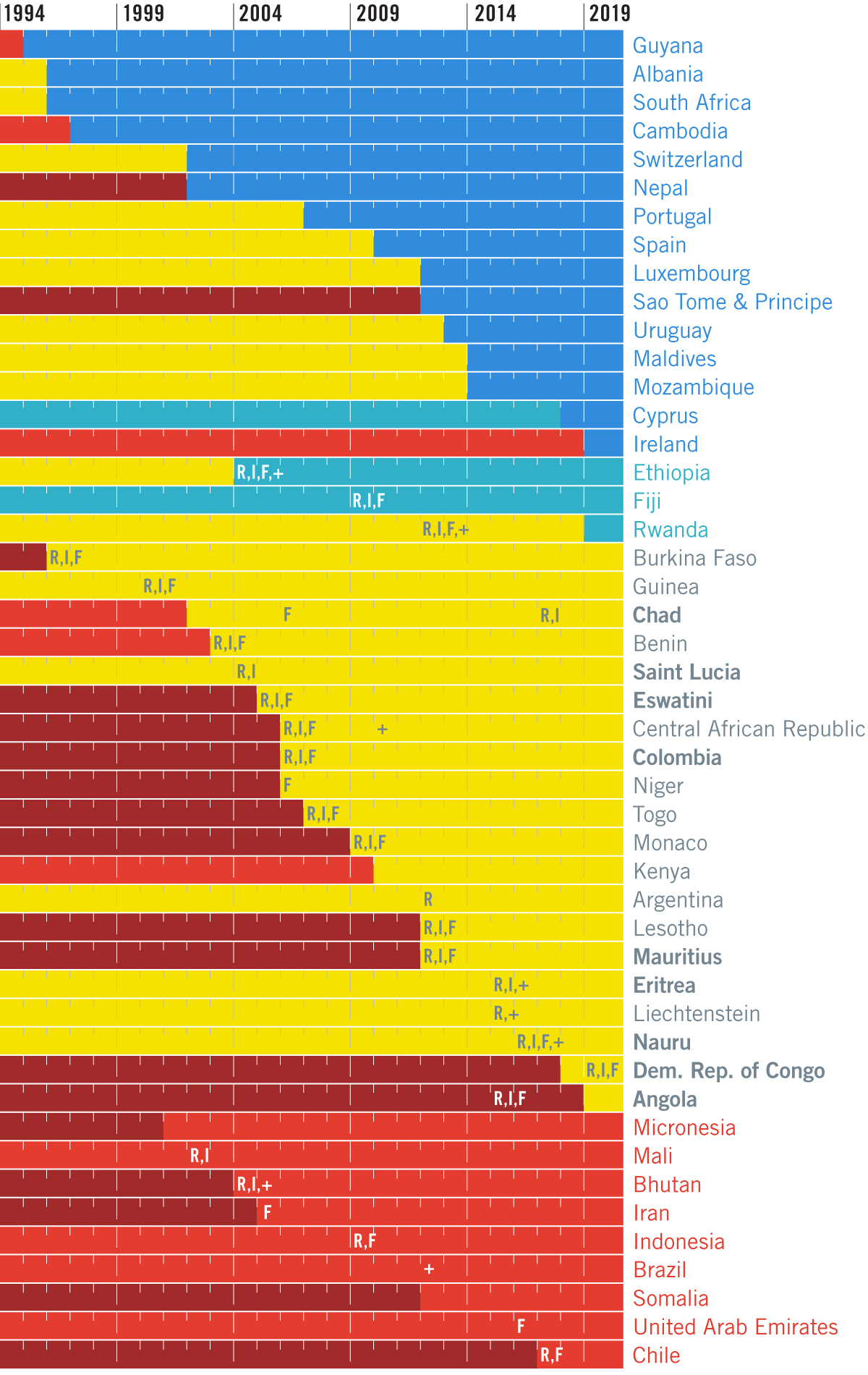Itã¢â‚¬â„¢s Easy to Be Prochoice Isnã¢â‚¬â„¢t It When You Are Not the One Being Chosenã¢â‚¬âÂ
The World's Abortion Laws
The World Abortion Laws Map is the definitive record of the legal status of abortion in countries across the globe. Since 1998, the Center for Reproductive Rights has produced this map as a resource for advocates, government officials, and civil society organizations working to advance abortion rights as human rights for women and girls* around the globe. The map categorizes the legal status of abortion on a continuum from severe restrictiveness to relative liberality. It is updated in real time, reflecting changes in national laws so human rights advocates can monitor how countries are protecting—or denying—reproductive rights around the world.
*Although this resource uses female pronouns as well as the term "women and girls," we recognize that people who do not identify as women also need access to abortion.
Supplementary Resources
The World Abortion Laws Map includes supplementary tools and resources to assist advocates and policymakers in advancing abortion reform. These include:
- Full text of 50 countries' abortion laws, available by viewing countries on the map
- Abortion Rights Are Human Rights
- Accelerating Progress
- Recent Developments
A list of countries categorized by their abortion law can be accessed by downloading a PDF of the map.
Methodology
The categorizations on the map reflect a strict reading of the black letter law in effect in each country. Abortion laws are categorized according to provisions in national statues, legal regulations, and court decisions. Ministerial guidelines are not utilized in categorizing the legal status of abortion on the map unless they have the force of law. Ashurst, DLA Piper, Gomez-Pinzon Abogados, and White & Case provided pro bono support in reviewing the laws of each country, with legal interpretations provided by practicing lawyers in each country when available. For the purpose of the map, "countries" include independent states, and where populations exceed one million, semi-autonomous regions, territories, and jurisdictions of special status.
Accelerating Progress
Over the past several decades, monumental gains have been made in securing women's right to abortion, with nearly 50 countries liberalizing their abortion laws. Some of this reform has been incremental, enabling women to access legal abortion only when there is a threat to her life or when pregnancy results from rape. But many of these changes have been truly transformative, overturning absolute bans on abortion in favor of women's reproductive autonomy.
View 25 years of progress:
The infographic below illustrates the change in countries' abortion laws over the past 25 years, using the color rubric from the World Abortion Laws Map. The change in color reflects the legality of abortion, before and after law reform was enacted. Where the change in law added enumerated grounds for abortion, these are reflected through lettered icons.

More information
Abortion Rights are Human Rights
The right to safe and legal abortion is a fundamental human right protected under numerous international and regional human rights treaties and national-level constitutions around the world. These instruments ground safe abortion in a constellation of rights, including the rights to life; liberty; privacy; equality and non-discrimination and freedom from cruel, inhuman and degrading treatment. Human rights bodies have repeatedly condemned restrictive abortion laws as being incompatible with human rights norms.
970 million women, representing 59% of women of reproductive age, live in countries that broadly allow abortion. While a majority of women live in countries where they can exercise their right to abortion, 41 percent of women live under restrictive laws. The inability to access safe and legal abortion care impacts 700 million women of reproductive age. According to the World Health Organization, 23,000 women die of unsafe abortion each year and tens of thousands more experience significant health complications. Legal restrictions on abortion do not result in fewer abortions, instead they compel women to risk their lives and health by seeking out unsafe abortion care.
The legal status of abortion indicates more than just where women and girls are legally permitted to decide whether to a pregnancy term or not. It also reveals how likely a woman is to die from unsafe abortion, whether girls will complete their education, and the limits on women and girls' ability to participate in public and political life. In short, tracking the legal status of abortion shows us where women and girls are treated with equality and are afforded the opportunity to direct the course of their own lives.
More information
Abortion Law and Policy Guide
Our Abortion Law and Policy Guide showcases international and regional human rights norms, global medical standards, and comparative laws and policies on the following topics:
- Legal Grounds for Abortion
- Life Exceptions
- Health Exceptions
- Broad Social or Economic Grounds
- On Request
- Rape and Incest Exceptions
- Fetal Viability and Impairments
- Gestational Limits
- Accessibility, Acceptability, Availability and Quality Framework
- Right to Information
- Informed Consent
- Medical Abortion
- Adolescents
- Third Party Authorization
- Criminality
- Conscientious Objection
Recent Developments
The Center for Reproductive Rights tracks the most recent developments in abortion law and policy.
- NSW joins the rest of Australian states in decriminalizing abortion, permitting abortion on request up to 22 weeks.
- Oaxaca becomes the second state in Mexico to decriminalize abortion.
- UK parliament votes overwhelmingly to adopt legislative provisions extending abortion rights to Northern Ireland and to legalize same-sex marriage
- Kenya's High Court rules the withdrawal of 2012 standards and guidelines on Reducing Maternal Mortality and Morbidity from Unsafe Abortion in Kenya illegal, holding abortion lawful on both physical and mental health grounds
- Iceland to have one of Europe's most liberal abortion laws, permitting abortion on request up to 22 weeks.
- North Macedonia removes regressive barriers to abortion and extends the gestational limit to abortion on request to 12 weeks, making abortion care more accessible to women in North Macedonia.
- South Korea's Constitutional Court holds laws restrictive abortion law unconstitutional, giving lawmakers until 2020 to pass new legislation legalizing abortion.
Explanation of Categories of Abortion Laws
Category 1. Prohibited Altogether

The laws of the countries in this category do not permit abortion under any circumstances, including when the woman's life or health is at risk. 24 countries globally fall within this category.
91 million (6%) women of reproductive age live in countries that prohibit abortion altogether.
Category II. To Save a Woman's Life

The laws of the countries in this category permit abortion when the woman's life is at risk. 41 countries fall within this category.
358 million (22%) women of reproductive age live in countries that allow abortion to save the life of the woman.
Category III. To Preserve Health

The laws of countries in this category permit abortion on the basis of health or therapeutic grounds. 48 countries fall within this category
186 million (12%) of women of reproductive age live in countries that allow abortion on health grounds.

These laws are generally interpreted liberally to permit abortion under a broad range of circumstances. These countries often consider a woman's actual or reasonably foreseeable environment and her social or economic circumstances in considering the potential impact of pregnancy and childbearing. 13 countries fall within this category.
386 million (24%) of women of reproductive age live in countries that allow abortion on broad social or economic grounds.
Category V. On Request (Gestational Limits Vary)

576 million (36%) women of reproductive age live in countries that allow abortion on request. 75 countries globally fall within this category.
The most common gestational limit for countries in this category is 12 weeks. Gestational limits are calculated from the first day of the last menstrual period, which is considered to occur two weeks prior to conception. Where laws specify that gestational age limits are calculated from the date of conception, these limits have been extended by two weeks.
Source: https://reproductiverights.org/maps/worlds-abortion-laws/
0 Response to "Itã¢â‚¬â„¢s Easy to Be Prochoice Isnã¢â‚¬â„¢t It When You Are Not the One Being Chosenã¢â‚¬âÂ"
Post a Comment